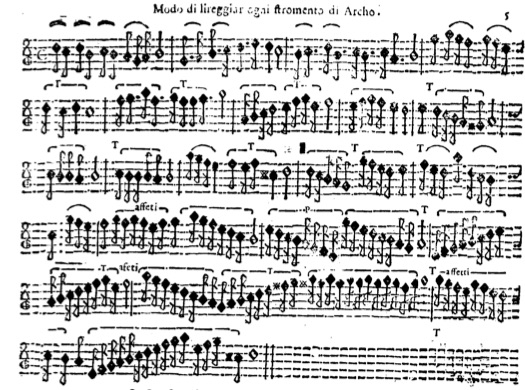A Timeline history of the Violin Bow - from c. 1600 - 1800
... the sources in detail ...
Francesco Rognoni Selva de varii Passaggi (1620)
(Facsimile published by Arnaldo Forni Editore, 1983, with an excellent Preface and translations of both Riccardo and Francesco Rognoni by Bruce Dickey. You can find an online facsimile on imslp, here)
Francesco Rognoni (2nd half 16th century - after 1626) was one of Riccardo's two sons. Active and highly respected in Poland, Italy and Austria, he published, in addition to this Selva, a violin method Aggiunta del scolaro - sadly lost, various collections of secular and sacred music, and had promised a method book for all instruments, which never appeared. Here are the passages directly concerning bowing:
„The viole da brazzo, especially the violin, is an instrument in itself crude and harsh, if it is not tempered and softened by gentle/delicate [soave] bowing. This those players should learn who have a certain crude way of playing without drawing [stendar] the bow above the viola and who lift it with such force that they make more noise with the bow than sound. What is more, they do not bow four eighth notes or sixteenths which are equal one to the next but they go on with the bow jumping on the viola so that it appears to devour the notes, not letting them all be heard with an equal bowing very close to the viola as good players do … The passaggio must be made of equal notes and such that they can be heard note by note, not too fast or too slow, but following a middle road, drawing the bow well above the viola. …
Everyone should know the true way of playing upon the soprano, as far as bowing is concerned. When whole note rests are found, you must begin by pulling the bow downwards; when there are half notes or sospiri, by pushing it upwards. Similarly, when you find a passaggio beginning directly in sixteenths or thirty-seconds, pull downwards; if the passaggio is preceded by an eighth note [rest?] you may push the bow upwards and this is the natural way“
Everyone should know the true way of playing upon the soprano, as far as bowing is concerned. When whole note rests are found, you must begin by pulling the bow downwards; when there are half notes or sospiri, by pushing it upwards. Similarly, when you find a passaggio beginning directly in sixteenths or thirty-seconds, pull downwards; if the passaggio is preceded by an eighth note [rest?] you may push the bow upwards and this is the natural way“
In the first part of this quote, Francesco is quite clearly concerned with the question of sound. When one considers how new the violin is, and that we are coming from a time when the normal string sound was that of the Viola da Gamba, his recommendation to stay close to the string makes more sense. In the second paragraph, he's talking about bowing, and although it's not crystal clear, I can see no other reading than a concern (like his father) with bowing "the right way round" - down bow on the notes on the beat.
Ha also writes about legato bowing;
Ha also writes about legato bowing;
By legato bowing (lireggiare) we mean playing two, three, or more notes in a single bow stroke, as can be seen in the opposite examples; if there are two, then two down and two up; if there are three, the same; if four, then four up and four down; if there are eight or twelve, the same so that the bow stroke lasts to where the line below ends [sic: must mean the line above--i.e., the slur mark]. It is also done with five or six notes. If you want [this bowing] to have a good effect, you must practise it slowly, giving pressure to the wrist of the bow hand. You should know that this sign T means to draw the bow downwards, and P means to thrust it upwards. This method of legato bowing will serve for all the stringed instruments.
Legato bowing in the affettuoso manner (il lireggiare affettuoso), that is, with affetti, is the same as the kind described above, as far as the bow is concerned. However, it is necessary for the wrist of the bow hand, almost jumping, to beat each note, one at a time. This is difficult to do well, and thus much practice is needed to be able to do it with the beat, conforming to the note values, [whereby] you should be careful not to make more noise with the bow than with the sound.
Legato bowing in the affettuoso manner (il lireggiare affettuoso), that is, with affetti, is the same as the kind described above, as far as the bow is concerned. However, it is necessary for the wrist of the bow hand, almost jumping, to beat each note, one at a time. This is difficult to do well, and thus much practice is needed to be able to do it with the beat, conforming to the note values, [whereby] you should be careful not to make more noise with the bow than with the sound.
